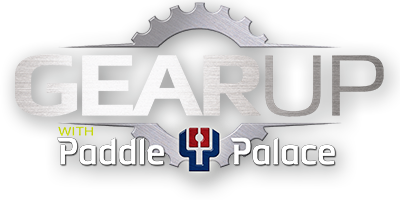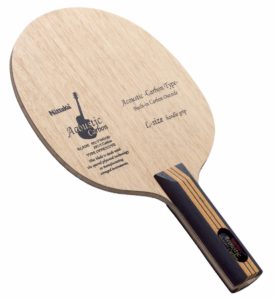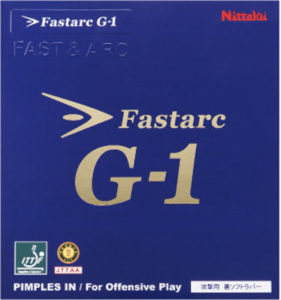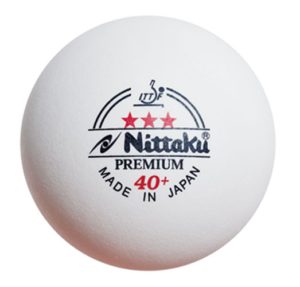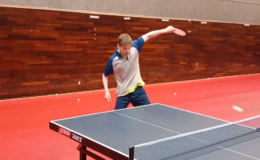
Choosing a Blade
by Samson Dubina
Choosing the right blade is one of the most important equipment decisions you will ever make. Thankfully, the Paddle Palace catolog lists the exact desciptions of each blade they sell. In this article, I’m going to talk about the details of various shakehands blades.
Handle Shape
There are various types of shakehands handles – straight, flared, conic, anatomic, ergonomic, and left-right. The handle shape is the one aspect of a blade that is a personal preference. Keep in mind that straight and flared are the most common. Also, if you are a chopper or blocker who twiddles often with a combination racket of pips or anti on one side, then it is best to use a straight handle as it is easier to twiddle your racket.
Ply
Some blades are all wood and listed as 5W, 7W, 9W etc… This means 5-ply wood, 7-ply wood, 9-ply wood. Other blades are made of wood plus carbon, glass fibre, texalium, titanium, aluminum, Kevlar, synthetic, arylate, aramid, or zylon. Wood blades tend to be more flexible with better touch on the control shots like pushing, flipping, and blocking. Composite blades tend to be faster with a larger sweet spot giving the most power on the loops and smashes. If you are a beginner, I would recommend using a 5-ply wood blade. As you progress to an intermediate-advanced level, I would recommend that you try out a composite blade.
Thickness
The blade thickness does have an impact on the “feel” of the blade; they usually range from about 5-9mm thick. Thinner blades around 5-6mm sometimes have a bit more vibration and thicker blades 7-9mm have less vibration.
Blade Measurements
This is one of the most overlooked aspects of a blade, but it is critically important. If you are a chopper or lobber playing further from the table, choose a larger blade so that you will have a larger surface area for making contact against loops and powerful smashes. If you are a quick offensive player, choose a smaller to mid-size blade for quick-close-to-the-table action. Also, consider how the head size adds significantly to the weight of the racket. If you choose a blade that is 16.6cm long and 15.6cm wide and weighs 85 grams, it will be heavier than a blade that is 15.6cm long and 15.0cm wide and weighs 85 grams. What? I thought they both weighed 85 grams. Yes, they do, the blades both weight 85 grams, but you aren’t just playing with the blade, you are playing with the rubber AND blade together. With a larger head, you have more rubber as well adding to the total weight of the racket.
Weight
For the weight of the racket, your selection should depend on your body type and your playing style. Stronger adults can use rackets that are 85-100grams. Physically weaker adults and very young children should use rackets that are 60-85 grams. Also, keep in mind that lighter rackets typically give more racket speed and heavier rackets typically give more force at impact. Lighter rackets are often better for close-to-the-table action and heavier rackets are better from mid to long-distance action. Another consideration is where the weight is distributed. Some rackets are more top-heavy and other rackets have more weight in the handle. The racket itself is one of the main aspects of the weight but also the thickness of the sponge – heavy rubber with thick sponge makes it more top-heavy and lighter rubber with thin sponge makes to more balanced or even handle-heavy.
Class/Speed/Control
This is probably the most obvious description. If you are an offensive player, then use an off+, off, or off- blade; all-around players use all+, all, or all-, defensive players use def+, def, or def-. Usually, faster blades give more speed. Usually, slower blades give more control and less speed. As you are developing your own game, think about the most important aspect. Do you win most of your points with power shots like fast flips, loops, and smashes? Or, do you win most of your points with placement, precision, variation, and consistency? As you learn more and more about your own game and the ways you win points, you will have a better understanding of what blade is best for you.
Price
Wood blades usually range from around $40-$150. Composite blades (like carbon), usually range from around $100-$300. One thing to consider is the life of a blade. As long as your store it properly in the case and your don’t destroy it on the table, your blade should last 10-20 years. This is a one time purchase, so make sure that you choose the right blade for you instead of just trying to find the “cheapest” blade.
Combo
Paddle Palace now offers combo specials including blade and rubber together on some of their blades. Make sure to have the experts at Paddle Palace assemble your racket – the assembly is free and they do a great job!
Samson uses the Nittaku Acoustic Carbon Large Grip Blade (Recent Change!) with Nittaku FastArc G1 rubber on both sides along with Nittaku 3- StarPremium 40+ balls.
- Read more great coaching and playing articles by Samson
